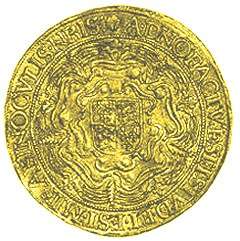The First Gold Sovereign: 1489
Synopsis
The pound sterling had been a unit of account for centuries, first coming into existence in 1489 under the ruling of King Henry VII. Now for the first time a coin denomination was issued with a value of one pound sterling. This new coin weighed 240 grains which equals 0.5 troy ounces or 15.55 grams, and was made using the standard gold coinage alloy of 23 carat, equal to 95.83% fine.

The First Design
The obverse design showed the King seated facing on a throne, a very majestic image. It is from this image of the monarch or sovereign that the new coin gained its name - the sovereign. The reverse type is a shield bearing the royal arms, on a large double Tudor rose. One of the reasons for the issue of the sovereign was to imitate similar large gold coins being produced on the Continent, another was to impress Europe with the power, prestige and success of the new Tudor dynasty.
Leading Designer of the Age
For the introduction of this important new coin, and later the shilling, the leading German engraver Alexander of Bruchsal was commissioned. The new sovereign has been described as "the best piece ever produced from the English mint". Alexander came to be described as "the father of English coin portraiture". He also produced the testoon or shilling of which it has been said that "modern coinage begins with the shilling of Henry VII".
Doubles and Trebles
A double or treble sovereign was also issued for Henry VII from the same dies as the sovereign, but thicker and heavier. These were possibly intended solely as presentation pieces. This first sovereign occurs with a number of minor type variations all of which are rare, currently cataloguing from £7000 upwards.
Henry VIII And The First Half Sovereign
Sovereigns were then struck for Henry VIII from 1509, and a half sovereign was also introduced during his reign. In 1526 the official value of English gold coins was raised by 10%, making a sovereign worth 22 shillings (22/- or 22s.), and then shortly after they were again revalued to 22s6d. A number of new gold coin denominations were introduced with a lower gold fineness of "only" 22 carat, equal to 91.66%. In 1544 a lighter sovereign was issued, weighing 200 grains, but still in 23 carat gold alloy.
Edward VI
Under Edward VI, sovereigns, half sovereigns, and double sovereigns were struck. His first sovereigns, issued between January 1549 and April 1550, were only in 22 carat gold. From 1550 to 1553, "fine" sovereigns were once again issued with a value of thirty shillings, and also a "standard" sovereign at twenty shillings.
Reverse of Edward VI Sovereign

Obverse of Edward VI Sovereign

Mary
During the sole reign of Mary, "fine" sovereigns were struck with a value of thirty shillings (30/- or 30s.), but during her slightly longer joint reign with Philip, no sovereigns were issued.
Elizabeth I
During the long reign of Elizabeth I, "fine" gold sovereigns, with a very high (99.4%) gold content, continued to be issued with a value of thirty shillings. A separate one pound gold coin was also issued, obviously with a value of twenty shillings.
Reverse of Elizabeth I Gold Sovereign

Obverse of Elizabeth I Gold Sovereign

James I - The Unite Appears
In the first coinage produced under the reign of James I, from 1603 to 1604, sovereigns of twenty shillings were issued before being discontinued, the previous pound coin was made lighter and renamed as a "unite". So after 115 years, this was the last sovereign to be issued until the emergence of the modern gold sovereign in 1817.
Obverse of the Gold Unite

Reverse of the Gold Unite

Related Blog Articles
This guide and its content is copyright of Chard (1964) Ltd - © Chard (1964) Ltd 2024. All rights reserved. Any redistribution or reproduction of part or all of the contents in any form is prohibited.
We are not financial advisers and we would always recommend that you consult with one prior to making any investment decision.
You can read more about copyright or our advice disclaimer on these links.





















